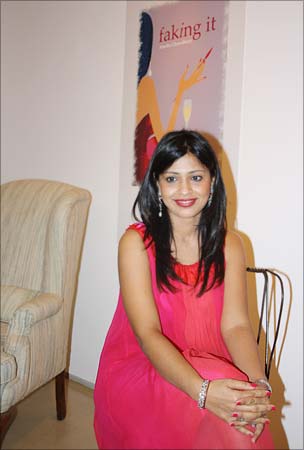
For years, when discussing overseas desis, the buzz word was 'Non-Resident Indian', or NRI. Now, however, NRI has come to mean something entirely different -- the Newly Returned Indian.
You know, the waves upon waves of British Indians, Indian Americans, Arab Indians and Indian Indians who have returned to 'India Shining' with Western degrees in hand and a desire to make their future while getting in touch with their roots.
Meet Amrita Chowdhury, a freshly minted novelist who perfectly fits this criteria of Newly Returned Indian.
As she herself says, she took the 'usual track' of first going to IIT (Kanpur), then to school in the US, where she earned her bachelor's (at the University of California, Berkeley) and ultimately her MBA (at Carnegie Mellon). There, in the states, she was a successful engineer and consultant. She also worked in Australia.
But Amrita, like seemingly countless young Indians, felt the pull back to the mother land, and is now settled in Mumbai with her husband and children. So who better to share the story of a fictional Newly Returned Indian, than Amrita herself?
Her first novel -- Faking It -- tells the tale of finance expert Tara Malhotra, who must give up her idyllic life in Washington DC and return to India when her hotshot banker husband gets a big promotion (read the excerpt here). What happens then is more than a bit crazy, to say the least!.
In an interview with rediff.com, Amrita discusses the differences between engineering and novel writing, and why she thinks there's a Bollywood screenplay lurking in the pages of her thriller.
Congratulations! First question, how does it feel to be a published novelist?
Feels really great. Its been the realisation of a long and secretly-held dream.
Did you read a lot when you were younger? Who were your favourite authors and what were your favourite books?
Yes, I have always been a voracious reader. As a youngster, I read everything from popular kids series to classics to even my mom's psychology texts. I remember, in school, reading Pride and Prejudice some 30 times over a summer holiday. I loved Wodehouse books and Byron's poetry. Then in college, I went through the usual phase of existentialist literature -- Camus, Kafka, et al, and also Kundera and Proust. In my first year as a student in the US, I had the budget of buying two Wodehouses a month to build my collection. Also, I loved the used book stores and found many, many books you never find in normal stores. Now, I read everything from literary to commercial genres, global and Indian authors, fiction and non-fiction.
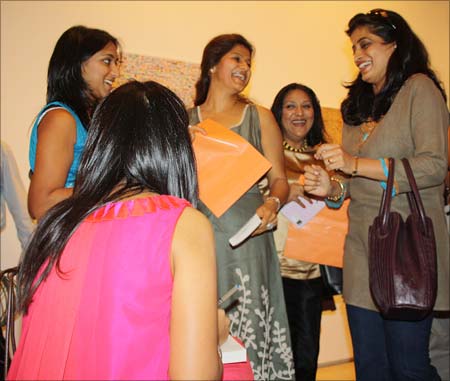
As a youngster, did you have a creative side that was shelved while you pursued your education in sciences?
I have always had a creative side to me. Even while pursuing engineering and later management, I wrote a smattering of poetry, explored different styles -- free verse, metered rhyme, sonnets, haiku. I also used to perform classical and contemporary dance. But, yes, it was tough to make enough time for creativity or a long project. There was also the fear to break away from the norm, to enter the unstructured domain and succeed in it.
So I went through the usual track -- IIT, US, MBA, consulting -- harbouring a secret dream of becoming a writer.
Did you ever write fiction before this effort? Written in any other capacity?
Yes, I have published short stories in magazines. I also have lots of poetry which I hope to publish someday -- not as my second book though.
How does writing fiction compare to your engineering work? What different and same skill-sets does it require?
Both engineering and management consulting work require structured thinking. Also, working in environments of short deadlines and high expectations has taught me things about time management and effective goal-oriented working styles. So, these skills have definitely helped in charting my course through an unstructured creative effort and in bringing it to completion.
Creative writing is very different from the world of precision. The grey areas matter a lot. It is that ability to understand and convey ambivalence, to beat about the bush to describe a thing, that old adage of show-don't-tell, that willingness and freedom to carry multiple skeins of thought and somehow weave them into a tapestry - in all of these way creative writing challenges the usual norms of the business and engineering worlds.
Now, of course, lateral thinking is really big in the business world and people are keen to explore 'creative' ways of ideation. Still, there is a difference.
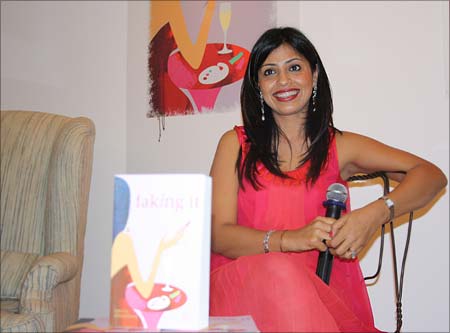
How did you make the specific decision to write Faking It?
When I moved back to India, after the initial settling phase, I decided to take the time and put in the effort into realising my long-held dream of writing a book. I had a few different ideas in different genres. I chose to write a book set in the art world because I enjoy art, I love to collect a bit and thought it would be fun to write a book that combined art forgeries and the reverse migration experience.
How did the creation part of the story-writing process go? How did the story formulate and come together? Did you have any 'Aha!' moments while writing? Or was it a long, difficult process?
I had a basic book structure in mind when I started writing. But as I wrote, the story evolved and morphed, characters got fleshed out more, and the plot changed from more of social satire to art thriller. I find writing like meditation, and once in that state, I am in the skin of various characters, words come out, often surprising me. I write copiously. For me, the tough part was to edit myself, to contain the words and keep the plot moving. The editing process helped immensely in this.
Where did characters like Tara, Raj and Roy come from? Drawn from personal experiences, or completely conjured up in your mind?
As with any other writer, I draw inspiration from life and from multiple sources - not only my experiences, but a combination of experiences of people around me, media, news stories, et al. Each character -- Tara, Raj, Roy -- then built on the sum of these sources of inspiration, and combined with a heavy dose of imagination, emerged in my mind.
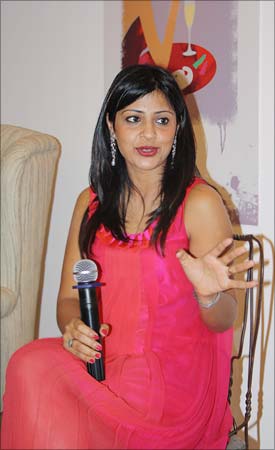
How much of this is autobiographical? The insights into Mumbai high-society, does it reflect your initial experiences/impressions in Mumbai?
Not autobiographical, but the book definitely draws inspiration from my initial experiences and those of others around me.
I love Mumbai, so it's all pretty tongue-in-cheek. Every reader will find a bit or a lot of Tara in themselves; she is fun, feisty and strong.
It contains elements of a NRI-come-home style-memoir, a romance novel and then a thriller/whodunit. How would you choose to describe the book?
I would choose to describe it as an intelligent and enjoyable book, with a fast moving plot, which is multi-layered and gives a lot of information in a fun manner. Early readers have described it as 'unputdownable' and that is a huge compliment.
It is a thriller. I can almost see a Bollywood screenplay in there.
How did you decide on contemporary Indian art as the subject of your book? Are you passionate about art? Was it difficult to write authoritatively about?
I chose art because I love and appreciate art. I collect contemporary Indian art, mostly emerging artists and a few known ones. I have studied Art History as a minor in undergrad. So, when I started writing, I had a little idea about art. So it was definitely scary and I did lots of research, spoke to many people and made multiple factual checks, again and again
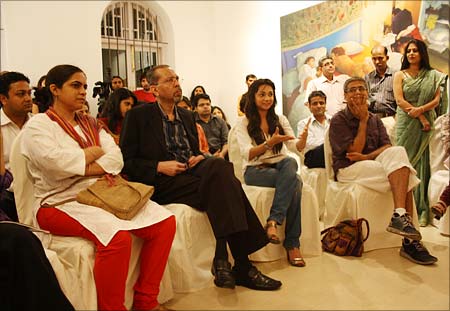
Whom all did you consult in the Indian art world to give your book that sense of authenticity?
My friend Ranjana Mirchandani Steinrucke was happy to talk art always and that really helped me in bouncing off ideas. I love the way her gallery (and few others) are trying to expand the vocabulary of art in India. Yashodhara Dalmia's biography on Amrita Sher-gil was a reference. Plus, I spoke to a large number of people -- artists, gallery owners, collectors, auctioneers, art fund managers, bankers who sell art. I also have a huge collection of art folios and I leafed through them many times. I consulted a large number of art resources on the web -- Indian Art blogs, sites on art conservation and forgery.
Was it difficult to find a publisher?
Yes and no. I tried contacting few agents in the US after writing the first three sample chapters. I got the usual reply that all new authors get - first finish the book. But one kind agent from New York gave me some feedback and it helped me make the heroine even stronger and gutsier. So a year later, after I finished the book, I spent 6 weeks contacting agents in the US, to no luck.
So I tried India and I heard from Nandita Aggarwal at Hachette within a week. I feel truly lucky -- it's been an amazing journey since then -- she has really helped shape the book. As a newbie author, it was crucial get that kind of support and encouragement. It's been fast journey too -- little over 6 months from contract to book release. I love the way Hachette backs its authors.
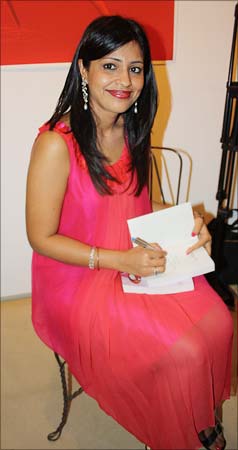
What are your expectations for the book?
I am getting good feedback from early readers.
It is a fun book. The heroine is a strong modern woman, who multi-tasks and juggles family, art business and chasing after the crooks. She is an optimist, who solves the trail of forgery and overcomes her own personal struggles.
I am sure readers will identify with her. There is also a lot of information about Art in a very engaging way and an easy-read for those not familiar with the Art world. It is also an intelligent book.
I expect the book will find resonance with a large number of readers. I think there is a movie in the book.
Do you plan to write fiction again?
Yes. I have already started on my second book, another thriller in a totally different setting. The protagonist is another strong gutsy girl, only younger than Tara. My third book will be the poetry I wrote before.
What other plans for the near future?
I had taken a sabbatical from management consulting to write to this book. I was able to balance time with my kids, who were quite young then, and write. Now I am back at work, as the Associate Director for Harvard Business School's India Research Centre and I am loving the pace and my work.